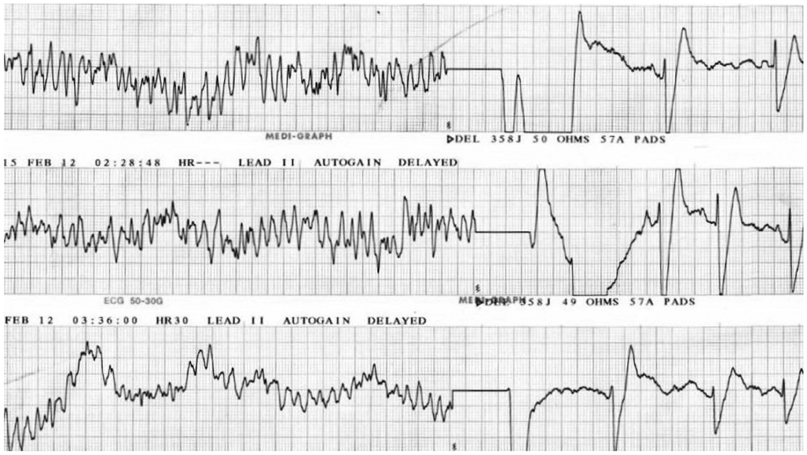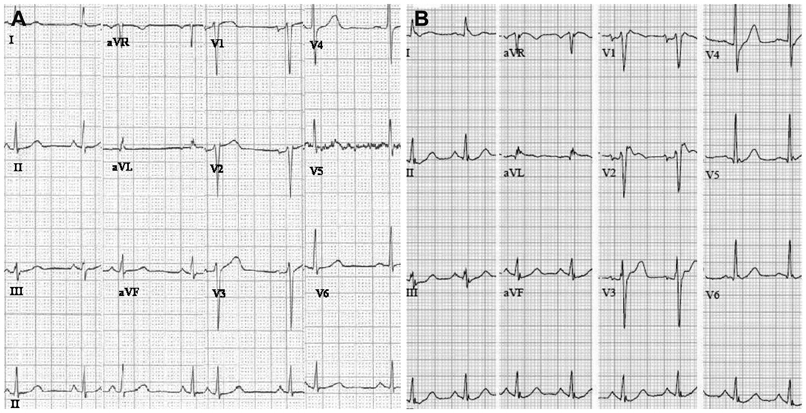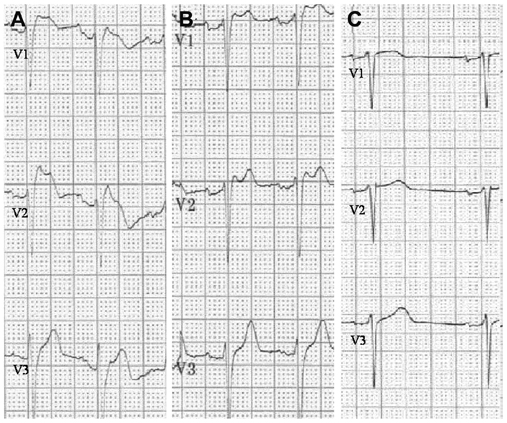Korean Circ J.
2013 Mar;43(3):193-195. 10.4070/kcj.2013.43.3.193.
Transient J-Wave Appearance in the Inferior-Lateral Leads during Electrical Storm in a Patient with Brugada Syndrome
- Affiliations
-
- 1Division of Cardiology, Department of Internal Medicine, Inha University College of Medicine, Incheon, Korea. kdhmd@inha.ac.kr
- KMID: 2224965
- DOI: http://doi.org/10.4070/kcj.2013.43.3.193
Abstract
- A 67-year-old male patient was admitted with an abrupt sudden cardiac death. He represented with an extreme electrical storm of 30 times of ventricular fibrillation (VF) episodes on one day. External shocks were performed to terminate VF. Transient J-wave in the inferior-lateral leads and Brugada electrocardiography pattern on the right precordial leads appeared during the electrical storm. And J-wave disappeared after the termination of electrical storm. We report a case of the appearance of J-wave during electrical storm in a patient with Brugada syndrome.
Keyword
MeSH Terms
Figure
Reference
-
1. Brugada P, Brugada J. Right bundle branch block, persistent ST segment elevation and sudden cardiac death: a distinct clinical and electrocardiographic syndrome. A multicenter report. J Am Coll Cardiol. 1992. 20:1391–1396.2. Haïssaguerre M, Derval N, Sacher F, et al. Sudden cardiac arrest associated with early repolarization. N Engl J Med. 2008. 358:2016–2023.3. Yan GX, Antzelevitch C. Cellular basis for the electrocardiographic J wave. Circulation. 1996. 93:372–379.4. Sarkozy A, Chierchia GB, Paparella G, et al. Inferior and lateral electrocardiographic repolarization abnormalities in Brugada syndrome. Circ Arrhythm Electrophysiol. 2009. 2:154–161.5. Letsas KP, Sacher F, Probst V, et al. Prevalence of early repolarization pattern in inferolateral leads in patients with Brugada syndrome. Heart Rhythm. 2008. 5:1685–1689.6. Kamakura S, Ohe T, Nakazawa K, et al. Long-term prognosis of probands with Brugada-pattern ST-elevation in leads V1-V3. Circ Arrhythm Electrophysiol. 2009. 2:495–503.7. Sorgente A, Sarkozy A, Brugada P. J-wave disappearance immediately after an episode of ventricular fibrillation in a patient with resuscitated sudden cardiac death and Brugada syndrome. J Cardiovasc Electrophysiol. 2010. 21:1413–1415.
- Full Text Links
- Actions
-
Cited
- CITED
-
- Close
- Share
- Similar articles
-
- Brugada Syndrome
- A Case of Idiopathic Brugada ECG Pattern Developed in Relation To Fever
- Anesthesia in a Patient with Brugada Syndrome without a Characteristic ECG Pattern: A case report
- Unmasking of the Idiopathic Brugada Electrocardiogram Pattern in a Febrile Patient with Pneumonia
- Brugada Syndrome Presenting With Convulsion in the Emergency Department: A Case Report




